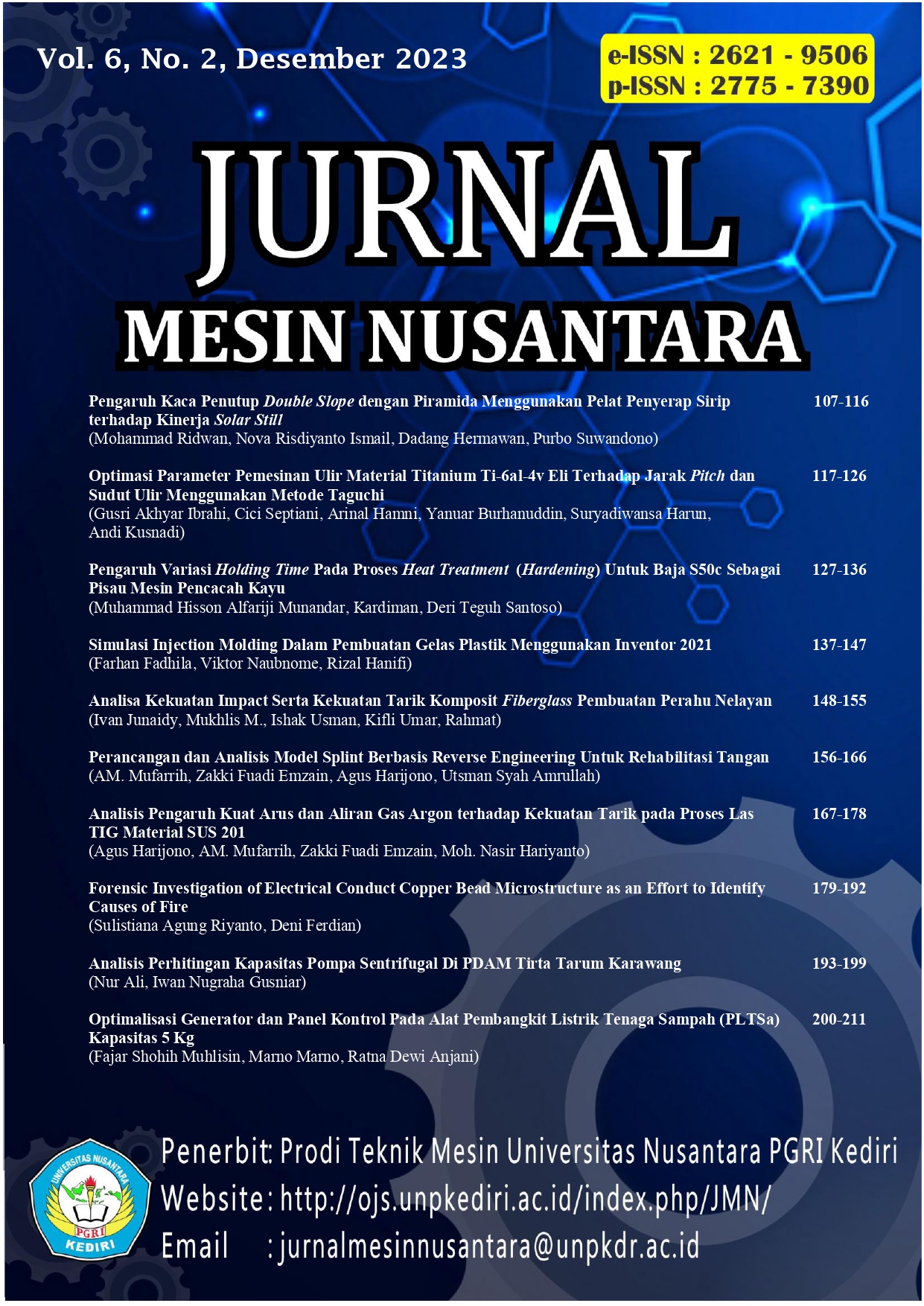Optimalisasi Generator Dan Panel Kontrol Pada Alat Pembangkit Listrik Tenaga Sampah (Pltsa) Kapasitas 5 Kg
DOI:
https://doi.org/10.29407/jmn.v6i2.19890Keywords:
Optimalization, Design, Waste Power Plant, Generator, Control PanelAbstract
Part of the Waste Power Plant (PLTSa) is the control panel. In the previous research on its use, namely the type of generator with a power output of 500 W, with a voltage output of 11.9 V and the duration of charging the battery by the generator for 8 hours with the direct jumper method to the battery. The purpose of this study is to determine the process of obtaining current and voltage from the generator to the battery & to determine the battery charging speed. The research method for this PLTSa device is to consider the type & weight of the waste, vapor pressure, and the current voltage of the electric power generated using 2 blowers with 40 watts of power each. The results of calculating the battery charge for 8.8 hours. Based on the measurement results, with a mass of 5 kg of waste and a pressure of 6 bar, the burning time for firewood is 25 minutes, wooden blocks are 31 minutes and coconut shells are 35 minutes. At the maximum point, the current in the generator when it reaches 1243 rpm is 9 Ampere and the resulting voltage is 12.9 V, so the power obtained is 115.2 VA which can rotate two blowers. The conclusion of this study is that the charging speed of the battery in PLTSa equipment can be increased by changes to the specifications of the generator and SCC MPPT, eliminating Auto cut and Automatic Transfer Switch to streamline current loads.
Downloads
References
R. Darmawan, “Rancang bangun turbin uap pada Pembangkit Listrik Tenaga Sampah (PLTSa) Kapasitas 1, 45 KW di Lingkungan Kampus Unsika”. Jurnal Teknik Mesin dan Pembelajaran, 4(1), 29-40. 2021
Monice and Perinov, “Analisis Potensi Sampah Sebagai Bahan Baku Pembangkit Listrik Tenaga Sampah (Pltsa) Di Pekanbaru”, SainETIn (Jurnal Sain, Energi, Teknologi & Industri), Vol. 1 No. 1, pp. 9 – 16, Des. 2016
R. Samsinar and K. Anwar, “Studi Perencanaan Pembangkit Listrik Tenaga Sampah Kapasitas 115 KW (Studi Kasus Kota Tegal)”, eLEKTUM, Feb. 2018
D. Oktariansyah, K. Mustafa, E. M. Aulawi, dkk. “Design and build a waste power plant (WPP) at the University of Singaperbangsa Karawang”. Teknika: Jurnal Sains dan Teknologi, 17(1), 67-77., 2021
R. Nasution, Armansyah, and Yusmartato, “Analisis Sistem Pembagian Beban Antar Generator”, Jurnal UISU, 2020
Y. Yusrizal and M. Qadri, “Perencanaan Sistem Pembangkit Listrik Tenaga Sampah Kapasitas 1000 Watt Dengan Proses Insinerasi”. Prosiding SEMDI-UNAYA, Vol. 1, No. 1, pp. 212-222, Nov. 2017
A. Y. Perdana, B. Astuti, and I. Akhlis, “Analysis of PWM-and MPPT-Solar Charge Controller Efficiency by Simulation”. Journal of Physics: Conference Series (Vol. 1918, No. 2, p. 022004)., IOP Publishing., Jun. 2021
B. Bakhtiar and T. Tadjuddin, “PEMILIHAN SOLAR CHARGE CONTROLLER (SCC) PEMBANGKIT LISTRIK TENAGA SURYA”. In Seminar Nasional Hasil Penelitian & Pengabdian Kepada Masyarakat (SNP2M) Vol. 5, No. 1, pp. 168-173, Nov. 2020.
H. Pradana, ”Rancang Bangun Arus Dan Tegangan Pada Pembangkit Listrik Tenaga Angin” Laporan Tugas Akhir, Fakultas Teknik, Teknik Elektro, Universitas Muhammadiyyah Sumatera Utara, 2021
E. M. Aulawi, “Rancang bangun alat insinerator untuk pembangkit listrik tenaga sampah (PLTSa) di UNSIKA”, Skripsi, Universitas Singaperbangsa Karawang, 2021.
Sularso and K. Suga, “Dasar Perencanaan dan Pemilihan Elemen Mesin”, Jakarta : PT. Pradya Paramitha, 2004.
M. Junaidi, D. Notosudjono, and E. Wismiana, “Perancangan Generator Dc Dengan Penggerak Mula Motor Ac Sebagai Free Energi”, Bogor : Jurnal Online Mahasiswa (JOM) Bidang Teknik Elektro, Vol. 1 No. 1, 2020
Downloads
Published
Issue
Section
License
Authors who publish with this journal agree to the following terms:
- Copyright on any article is retained by the author(s).
- The author grants the journal, right of first publication with the work simultaneously licensed under a Creative Commons Attribution License that allows others to share the work with an acknowledgment of the work’s authorship and initial publication in this journal.
- Authors are able to enter into separate, additional contractual arrangements for the non-exclusive distribution of the journal’s published version of the work (e.g., post it to an institutional repository or publish it in a book), with an acknowledgment of its initial publication in this journal.
- Authors are permitted and encouraged to post their work online (e.g., in institutional repositories or on their website) prior to and during the submission process, as it can lead to productive exchanges, as well as earlier and greater citation of published work.
- The article and any associated published material is distributed under the Creative Commons Attribution-ShareAlike 4.0 International License












